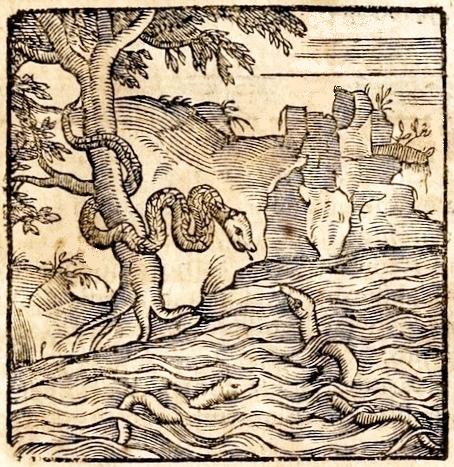The Eel And The Snake on:
[Wikipedia]
[Google]
[Amazon]
 The fable of the Eel and the Snake was originated by
The fable of the Eel and the Snake was originated by
Fable 5
/ref>
 The fable of the Eel and the Snake was originated by
The fable of the Eel and the Snake was originated by Laurentius Abstemius
Laurentius Abstemius (c. 1440–1508) was an Italian writer and professor of philology, born at Macerata in Ancona. His learned name plays on his family name of Bevilaqua (Drinkwater), and he was also known by the Italian name Lorenzo Astemio. A ...
in his ''Hecatomythium'' (1490). Versions of it appeared in several European languages afterwards and in collections associated with Aesop’s Fables
Aesop's Fables, or the Aesopica, is a collection of fables credited to Aesop, a slave and storyteller believed to have lived in ancient Greece between 620 and 564 BCE. Of diverse origins, the stories associated with his name have descended to m ...
.
The fable and its versions
The fable consists of a conversation between an eel and a snake. The eel observes that they are both alike and wonders why humans pursue itself with such energy while they avoid contact with the snake. The latter replies that this is because no one who tries to wound him goes away unharmed and from this the conclusion is drawn that those who avenge themselves are less likely to be injured. The fable was written in Latin prose and was later retold in Latin verse inGabriele Faerno
The humanist scholar Gabriele Faerno, also known by his Latin name of Faernus Cremonensis, was born in Cremona about 1510 and died in Rome on 17 November, 1561. He was a scrupulous textual editor and an elegant Latin poet who is best known now for ...
’s ''Centum Fabulae'' (1563) and shortly after in Italian verse in Giovanni Maria Verdizotti
Giovanni Maria Verdizotti was a well-connected writer and artist who was born in Venice in 1525 and died there in 1600.
Life and work
As an artist, Verdizotti is mainly remembered for his friendship with Titian, whose pupil he was, and later his ...
’s ''Cento Favole Morali'' (Venice 1570), both of which were largely reliant on Aesopian sources. Early English prose versions appeared in Philip Ayres’ ''Mythologia ethica, or Three centuries of Æsopian fables'' (1688), and attributed to Abstemius in both Roger L'Estrange
Sir Roger L'Estrange (17 December 1616 – 11 December 1704) was an English pamphleteer, author, courtier, and press censor. Throughout his life L'Estrange was frequently mired in controversy and acted as a staunch ideological defender of Kin ...
’s ''Fables'' (1692) and in the United States in ''An Argosy of Fables'' (New York 1921).
The story was also popular elsewhere in Europe and was retold in various versions in German by Johann Wilhelm Ludwig Gleim
Johann Wilhelm Ludwig Gleim (2 April 1719 – 18 February 1803) was a German poet, commonly associated with the Enlightenment movement.
Life
Gleim was born at the small town of Ermsleben in the Principality of Halberstadt, then part of Prussia ...
and Friedrich Schiller. In French there were versions, none of which deviated far from the original fable, among others by N.Ganeau in the 18th century, and in the 19th century by Louis-François Jauffret, Jean François Guichard, M. F. Devenet, and the Belgian Baron Goswin de Stassart
Goswin Joseph Augustin, Baron de Stassart (2 September 1780 – 16 October 1854) was a Dutch-Belgian politician.
Stassart studied accounting and economics in Paris. In 1804 he became Auditor in the French State Council, in 1805 he became Intenda ...
.''Fables'', Brussels 1818Fable 5
/ref>
References
{{DEFAULTSORT:Eel and the Snake, The Fables by Laurentius Abstemius